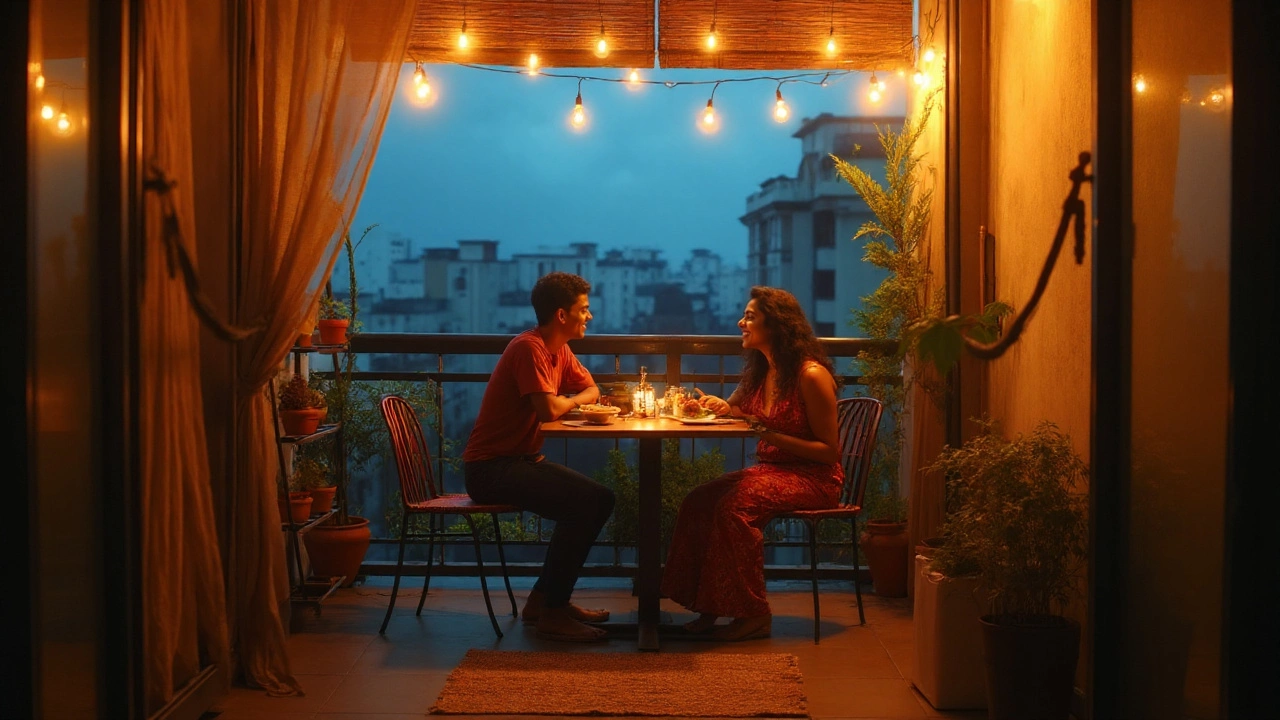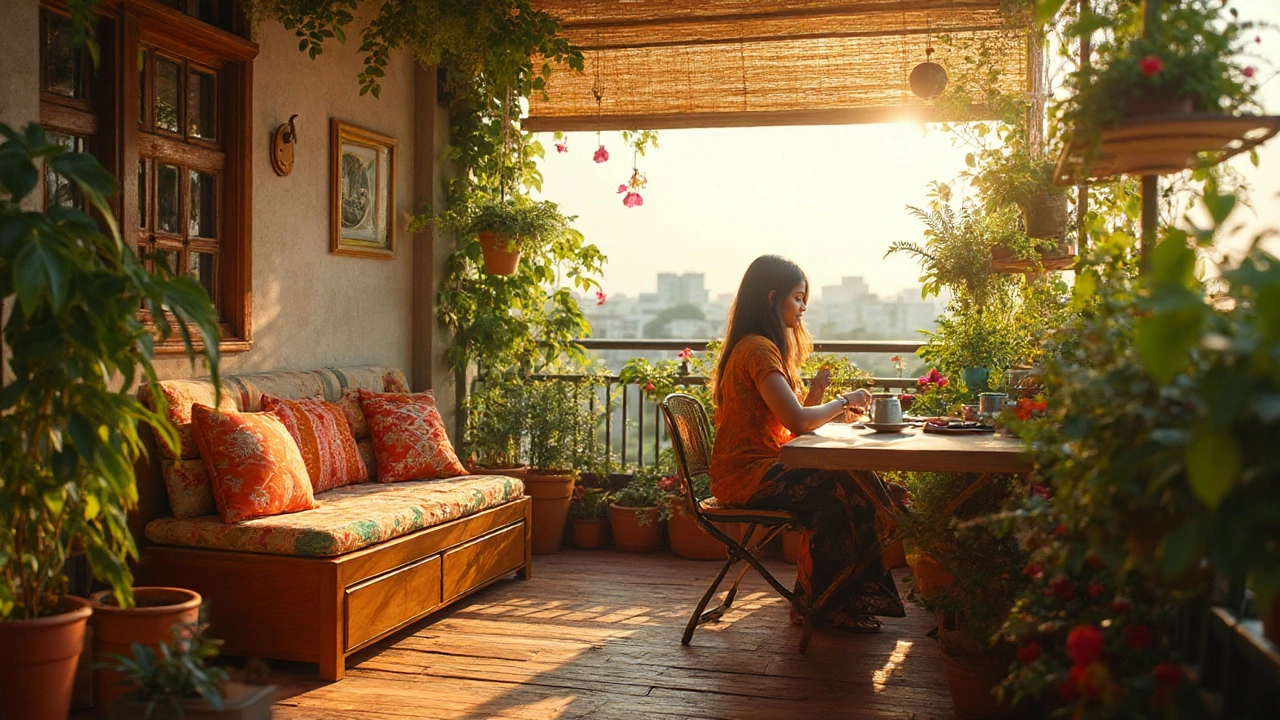Most balconies are tiny, awkward, and windy-especially in cities by the sea. But with a clear plan, you can turn 1-3 square metres into a place you actually use: morning coffee, a mini garden, or a quiet nook. I live in Auckland, where UV is fierce and gusts can tip a pot, so this guide leans practical. Expect a layout that fits two seats, real greenery, and hidden storage, all without annoying your body corporate or landlord.
TL;DR: Quick wins that actually fit
You’re here to maximize small balcony space without making it cluttered. Here’s the short version that works in real life:
- Pick one primary use (sit, grow, or store), then layer the other two. Use the 60/30/10 rule: 60% clear floor for moving, 30% flexible furniture, 10% vertical extras.
- Go vertical: rail planters, a slim ladder shelf, and a tension-pole plant stand. Keep heavy pots near walls, not on the edge.
- Furniture that folds or hides storage: a drop-leaf wall table, a storage bench, and two folding chairs you can hang on hooks.
- Wind and privacy: a reed or mesh screen on the inside of the railing, plus a movable trellis. Use cable ties, not screws, if you rent.
- Plants that can handle sun and wind (Auckland-friendly): thyme, rosemary, chives, strawberries, cherry tomatoes, dwarf citrus (40 cm pot), dwarf hebes, and coprosma. For shade: ferns and aspidistra.
- Watering made easy: self-watering planters or a simple drip spike setup. Water early to avoid dripping on neighbours.
- Budget ballpark (NZD): $300-$900 for furniture, planters, soil, and lighting. Start with $120-$200 for the highest-impact pieces.
Promise: if you stick to these, your balcony stops being a junk zone and becomes a little room you use daily.
Step-by-step: Measure, plan, furnish, green, and enjoy
Here’s a simple path that works for renters and owners.
-
Check rules and safety first. Ask your landlord or body corporate what’s allowed: screens, planters on rails, gas/electric grills, flooring tiles, and drilling. Balconies have load limits-ratings vary by building and design. Keep heavy items low, against structural walls, and spread out. Avoid hanging anything outside the railing. When in doubt, ask the building manager.
-
Measure and map conditions. Note width, depth, door swing, rail height, and fixed obstacles. Mark a 600 mm walkway from the door so you always have a clear path. Track sun and wind for a few days:
- Full sun: 6+ hours
- Part sun/part shade: 3-6 hours
- Shade: <3 hours
Auckland gets strong UV; NIWA’s summer UV index often hits 9-12, so fabrics and plants need to handle it. If you face west, plan for heat; if you face south, pick shade-tolerant plants.
-
Decide your primary job-to-be-done. Choose one:
- Relax zone (coffee/reading)
- Edible garden (herbs/greens)
- Utility + storage (bikes, drying rack)
Then layer the other two. Use the 60/30/10 rule so the space doesn’t choke. Keep the 600 mm walkway clear.
-
Lay the base: flooring and privacy. Clip-together deck tiles or an outdoor rug warms the space. Choose materials that drain and won’t rot. For privacy and wind, attach a reed or mesh screen to the inside of the rail with cable ties. If drilling isn’t allowed, try freestanding planters as a weighted trellis base.
-
Pick smart furniture (small footprints that move).
- Drop-leaf wall table or a rail-hanging balcony table (great on narrow balconies).
- Two folding bistro chairs that stack or hang on hooks.
- Storage bench (80-100 cm long) doubles as seating; store potting mix and tools inside.
- Side table that nests under the bench or stacks.
Aim for pieces 40-50 cm deep. Keep corners open for a bigger feel.
-
Go vertical with plants. Start with rail planters mounted on the inside. Add one slim ladder shelf (max 30 cm deep). If drilling is a no-go, use a tension-pole plant stand or a freestanding rack. Choose planters with saucers or self-watering bases to prevent drips.
Plant picks by light and wind (Auckland-friendly):
- Full sun + wind: thyme, rosemary, oregano, chives, strawberries; cherry tomatoes (stake and tie); dwarf citrus in a 40-50 cm pot; dwarf hebes (‘Wiri’ series), coprosma.
- Part sun: lettuce, rocket, spinach, mint (in a separate pot), parsley, dwarf capsicum, marigolds, calibrachoa.
- Shade/sheltered: ferns (e.g., hen and chicken fern), aspidistra, pothos, monstera (avoid cold snaps), kawakawa in a large, sheltered pot.
Container sizes that work: herbs: 20-25 cm pots; strawberries: bowls or long rails; tomatoes/citrus: 30-50 cm with support; dwarf shrubs: 30-40 cm. Use quality potting mix with slow-release fertiliser; add 10-20% pumice for drainage. Top up with liquid feed every 2-3 weeks in the growing season.
-
Tame wind and tie things down. Use soft ties or Velcro to secure tall plants to railings or trellises. Weight planters with a few stones at the base. Don’t hang glass items. In storms, move light furniture inside.
-
Lighting, shade, and comfort. Pick solar or USB-rechargeable string lights (IP65). Clip a small rechargeable lantern to the rail. A small cantilever shade or outdoor curtain can take the edge off harsh sun-secure it well and check rules. Pick solution-dyed acrylic or polyester outdoor fabrics; NZ sun eats cheap cushions fast.
-
Watering and care. Self-watering planters save time. Or add bottle drip spikes for each pot. Water early, not late, to avoid dripping below. Weekly: deadhead, trim, and check for pests (aphids/whitefly). A mild soap-and-water spray works; test a leaf first.

Real layouts and budgets: three small-balcony setups
These are sized for common apartment balconies. Costs are rough 2025 NZD from typical big-box stores and garden centres-buy second-hand to drop the budget fast.
1) Narrow balcony: 0.9 m × 2.4 m (2.2 m²)
- Rail-hanging table (80-100 cm wide, 25-35 cm deep) on the inside.
- Two folding bistro chairs that hang on hooks when not in use.
- Three rail planters (60 cm) for herbs and strawberries.
- One slim ladder shelf (30 cm deep) against the wall for pots and a lantern.
- Outdoor runner rug or 4-6 packs of clip tiles depending on coverage.
Plants: thyme, chives, mint (own pot), strawberries, cherry tomatoes (one plant on a stake).
Budget: $350-$650 (table $80-$150, two chairs $60-$120, planters $45-$90, tiles/rug $80-$150, soil and plants $60-$140, hooks and ties $20).
2) Compact rectangle: 1.5 m × 2.0 m (3.0 m²)
- Storage bench (100 cm) along the short wall + one folding chair.
- Drop-leaf wall table (folds flat) or a little nesting side table.
- Two 30-40 cm pots: dwarf citrus and a dwarf hebe; keep them near the wall.
- Rail screen for privacy; hang lightweight herbs on the inside.
- USB string lights and one solar lantern.
Plants: dwarf lemon or lime; dwarf hebe; parsley, rocket, and basil in a long rail trough.
Budget: $500-$900 (bench $120-$250, table $80-$130, pots $60-$120, screen $50-$120, lights $30-$80, tiles/rug $80-$150, soil and plants $80-$150).
3) Versatile small-medium: 1.8 m × 3.0 m (5.4 m²)
- L-shaped seating with cushions (storage underneath if possible).
- Clip tiles across the main zone + rug layer for warmth.
- Tension-pole plant stand in a corner, plus one freestanding trellis planter as a movable screen.
- Rail planters for spillover color (calibrachoa, petunias) or salad greens.
- Fold-out drying rack you can store behind the bench.
Plants: rosemary (trimmed into a mini hedge), strawberries, mixed salad greens, a feature shrub like coprosma in a 35-40 cm pot.
Budget: $800-$1,500 depending on seating build and tile coverage.
| Item | Typical size | Approx. weight/load | NZD cost (2025) | Notes |
|---|---|---|---|---|
| Folding bistro chair | 40-45 cm W × 45 cm D | 3-6 kg each | $30-$60 | Hang on wall hooks when not in use |
| Rail-hanging table | 80-100 cm W × 25-35 cm D | Limit to light loads (mugs, laptop) | $70-$150 | Mount inside the rail; check clamp fit |
| Storage bench | 80-120 cm W × 40-50 cm D | 15-25 kg empty | $120-$250 | Double-duty seating and storage |
| Clip deck tiles | 30 × 30 cm per tile | 1-1.5 kg per tile | $35-$60/m² | Allow drainage; renters can lift later |
| 40 cm pot (filled) | Volume ~30-40 L | 25-35 kg damp | $25-$60 | Keep near wall; secure tall plants |
| Self-watering trough | 60-80 cm long | 10-18 kg filled | $35-$80 | Good for herbs and greens |
| Reed/mesh screen | 1-1.5 m H × custom length | Light; wind-permeable | $45-$120 | Attach with cable ties inside the rail |
| Potting mix (premium) | 40 L bag | ~12-16 kg | $15-$22 | Add pumice 10-20% for drainage |
Checklists, cheat-sheets, and rules of thumb
Measure once, buy right:
- Width × depth of floor; subtract 60 cm for a walkway from the door.
- Rail height and thickness (for clamps/tables/planters).
- Door swing: hinging side and arc. You need clearance.
- Sun hours: morning vs afternoon, summer vs winter.
- Wind direction/gusty corners; any overhang above you.
- Rule check: drilling allowed? External-hanging items banned? BBQ rules?
Shopping list starter (budget-friendly):
- 1 × foldable table (drop-leaf or rail-hanging)
- 2 × folding chairs + 2 heavy-duty wall hooks
- 2-4 × rail planters (with saucers or self-watering bases)
- 1 × slim ladder shelf or tension-pole plant stand
- 4-8 × clip tiles or 1 outdoor rug
- 1 × reed/mesh screen + cable ties
- Premium potting mix + slow-release fertiliser + pumice
- USB/solar string lights + 1 lantern
Plant cheat-sheet (pick 5 to start):
- Sun + wind: rosemary, thyme, oregano, chives, strawberries, cherry tomato (one plant).
- Part sun: basil (shelter from wind), parsley, rocket, lettuce, marigolds.
- Shade: ferns, aspidistra, pothos; kawakawa if sheltered from wind.
Safety and neighbour-friendly rules:
- Keep heavy pots against walls; avoid the rail edge.
- Never hang items outside the rail. Secure everything you can lift with one hand.
- Water early; use saucers or self-watering planters to stop drips.
- In storms, bring light items in. Tie tall plants to supports.
- Check building rules before screens, tiles, or BBQs.
10-minute weekly routine:
- Water check: finger in soil knuckle-deep; if dry, water slowly.
- Snip dead leaves/flowers; harvest herbs to keep them compact.
- Wipe rail/table; shake out the rug.
- Pest scan: look under leaves; soap-spray if needed.
- Top up liquid feed every 2-3 weeks in spring/summer.

FAQ and next steps
What’s the best flooring for renters? Clip deck tiles or a breathable outdoor rug. Both lift out cleanly and let water drain. Avoid glues.
How do I water when I’m away? Self-watering planters or bottle drip spikes. Group pots tighter in the shade and water deeply before you go. Mulch the surface with fine bark or coconut coir to slow evaporation.
How do I stop water dripping to neighbours? Use saucers or self-watering bases. Water early morning so any spill dries by midday. Don’t overfill saucers; empty after heavy rain.
What about pigeons or seagulls? Keep food off the balcony. Run a near-invisible fishing-line grid 10-15 cm above rail planters, or use light pinwheels. Avoid spikes if your building bans them.
Will plants survive Auckland wind? Yes, if you choose tough species and secure them. Herbs like rosemary/thyme love sun and breeze. Tie tomatoes and dwarf citrus to a stake. Use heavier pots or add a few stones at the base.
Which fabrics won’t fade? Look for solution-dyed acrylic or outdoor-rated polyester. Store cushions in a bench or bag when not in use-NZ UV is brutal in summer.
How many big pots are safe? There’s no single number-balcony ratings vary. A simple rule: limit large, heavy pots, keep them near structural walls, and spread the weight. If you plan more than a few 40-50 cm pots, ask your building manager about load ratings.
What grows on a south-facing balcony in NZ? Shade lovers: ferns, aspidistra, pothos, peace lily (if it’s warm), and mint/parsley for edibles. Avoid heat-lovers like tomatoes unless you can give them extra light and shelter.
Next steps if you rent:
- Confirm rules on screens, rail planters, and tiles.
- Buy two folding chairs, one rail or drop-leaf table, and two planters.
- Add a reed/mesh screen with cable ties on the inside of the rail.
- Start with 5 easy plants (herbs + strawberries) and one feature plant.
- Set a weekly 10-minute care routine.
Next steps if you own:
- Check with your body corp before drilling or adding permanent fixtures.
- Commit to a layout: bench with storage + drop-leaf table.
- Install clip tiles wall-to-wall, leaving drainage gaps.
- Build a movable trellis screen using planters as weights.
- Set up self-watering planters and low-voltage or solar lighting.
Troubleshooting quick fixes:
- Plants drying out fast: move them out of afternoon sun; add mulch; use self-watering planters.
- Leggy herbs: they need more light. Trim hard and shift them to the sunniest rail.
- Clutter creep: enforce the 60/30/10 rule; one-in, one-out for decor and pots.
- Wind toppers: switch to squat pots, add weight, and tie to supports.
- Smells after rain: improve airflow, clean saucers, and avoid waterlogged mats.
Set a timer for an hour this weekend: measure, pick your main job, and grab two items that give instant wins-a folding table and one vertical planter. The rest falls into place once you start using the space.





